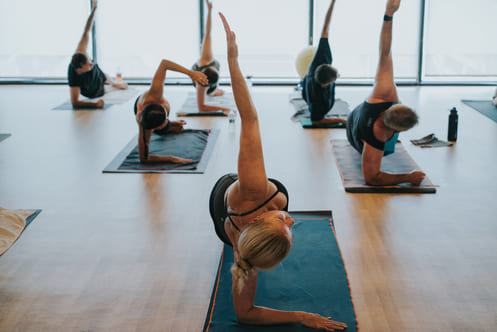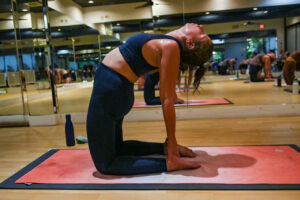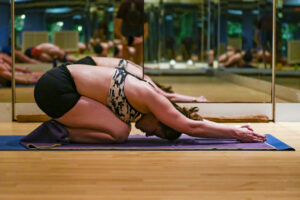In our busy, fast-paced lives, it’s easy to get swept away by our thoughts, feelings, and endless responsibilities. But what if we could find a way to slow down, turn down the volume, and just be still like you see when someone performs Corpse Pose in yoga class. You know, the pose where you lay flat on the floor looking like a corpse?
My friend, a mom to a vibrant 4-year-old, told me about how she helps her daughter wind down at bedtime. Her daughter is full of energy and ideas and often resists sleeping. As she sits there with her daughter and listens to her thoughts, she smiles at her and gently guides her back to her attention and then to her breath.
“Let’s turn down the volume on our thoughts for tonight,” she says. “Can you take a deep breath? Breathe in, breathe out.” Then she focuses her daughter’s attention on her body with a body scan. She tells her daughter that her thoughts will be there for her to revisit tomorrow.
This is the exact care and attention we should give ourselves when our minds become too noisy. It’s what Corpse Pose (Savasana) teaches us – the ability to gently guide our attention back to our breath, bodies, and the present moment.
In this blog post, we’ll explore the practice of Corpse Pose or Savasana in Bikram Yoga, how it allows us to “turn down the volume,” and the tranquility it brings into our lives – both on and off the mat.
Before diving in to the Corpse Pose, here is what we will cover in this article:
Bikram Yoga
Bikram Yoga, often called “hot yoga”, takes traditional yoga up a level of intensity. In a Bikram class, you’ll work through a series of 26 poses in a room heated to around 110°F with 60% humidity. This heat isn’t just about making you sweat (although you’ll do plenty of that); it’s about warming up your muscles and making them more flexible and responsive to the practice.
In Bikram Yoga, the poses vary from standing and balancing to seated and twisting. Here at Yogasol (a yoga studio in Norwalk, Connecticut), we offer 75 and 90-minute hot yoga classes. In the 75-minute class, the 26 hot yoga postures are all included, but the Savasana is held a little shorter.
Despite its intensity, Bikram suits all levels — from beginners to seasoned yogis. However, listening to your body is especially important if you’re dealing with injuries. Modifications and gentler versions of poses are always available, and we encourage everyone to move at their own pace. It’s not about pushing our bodies to their limit but instead finding a balance between effort and ease. If something doesn’t feel right, honor your body and ease off.
Step By Step Instructions for Corpse Pose
Though Corpse Pose or Savasana might look like a nap between poses, it’s actually a fully conscious pose aimed at being awake yet completely relaxed. In Savasana — just like in meditation — you remain fully alert and aware, yet free of any tension or stress. This conscious relaxation offers deep rest and revitalization to your body and mind.
If you’re coming out of Toe Stand, the 12th pose in the 26 Bikram Yoga poses, your heart might be racing, your breath may be quick, and your muscles engaged. Take a moment to acknowledge the effort you’ve put into practicing Toe Stand. Then, gently allow yourself to transition into the calmness of Savasana or Corpse Pose.
Step 1: Find Your Position
Lower yourself onto your mat, stretching out flat on your back. Allow your legs to extend outward, feet falling naturally to the sides. Your arms should rest alongside your body, palms facing the ceiling. This is your time to take up space, so let your body expand, and relax on the mat.
Step 2: Acknowledge Your Body
Close your eyes and take a moment to check in with your body. Your heart may still be racing from the Toe Stand, your muscles tingling from the effort. That’s okay. Just notice these sensations.
Step 3: Begin to Turn Down the Volume
Now, imagine a volume dial in your mind. It’s time to slowly and organically lower the volume of your thoughts. With each breath, picture the dial turning a notch lower.
Step 4: Ground Your Body
As your thoughts become quieter, bring your attention back to your body. Feel the ground beneath you, the weight of your body sinking into the mat. From your toes to your head, allow each part of your body to let go.
Step 5: Witness Your Thoughts
Your mind might be busy today, and that’s okay. Let your thoughts flow through you, and keep bringing your attention back to your breath. As you continue to breathe, picture your thoughts as clouds drifting across your mind’s sky. They are there, but you’re just observing, not holding onto them. Let them float by, coming and going as they please.
Step 6: Embrace the Stillness
As you practice this pose, you might reach a space of calm or stillness. Rest in this stillness. This is Savasana.
Step 7: Coming Back to Seated
Remain in this pose for as long as your practice allows. To come out of the pose, gently wiggle your fingers and toes, slowly bringing movement back into your body. Roll onto one side, taking a moment before gently pushing up to a seated position.
Body Benefits:
- Rest and Recovery: Savasana allows your body to rest and recover after or during a yoga sequence. Your breath can find a slower rhythm, your muscles can relax, and you can tune into how you feel.
- Improves Physical Health: Regular practice of Savasana may be linked to lower blood pressure and improved heart health. It can also promote better sleep and boost your immune system.
- Relieves Tension: The pose helps release tension in your muscles. As you consciously relax each part of your body, you can begin to let go of the tightness and stress you may be holding onto.
Mind Benefits:
- Cultivates Mindfulness: Corpse Pose encourages you to tune into your breath, sensations, and thoughts. This practice of mindful awareness can increase your focus and concentration and extend into your daily life.
- Reduces Stress and Anxiety: By turning down the volume of your thoughts and focusing on your breath, Savasana may help lower your stress and anxiety levels.
- Improves Emotional Health: The pose can also be therapeutic for depression and mood disorders. It provides a safe space for emotional release and self-exploration, promoting a better mood and overall emotional well-being.
- Enhances Self-Awareness: Corpse Pose offers a rare opportunity to just be — to observe without judgment, to listen without the need to respond. This can foster a greater understanding and acceptance of oneself, enhancing self-awareness and self-esteem.
Sanskrit
The Sanskrit name for Corpse Pose is “Savasana.” It is derived from two words: “sava,” which means “corpse,” and “asana,” which means “pose” or “posture.”
In yoga, the Sanskrit names of the poses often give insight into the intention or focus of the pose. Savasana is no different. Calling it “Corpse Pose” is a reminder that the pose is about complete relaxation and surrender, much like the stillness of a corpse.
It may seem like a morbid comparison, but in the philosophy of yoga, it is often interpreted as a symbolic death. By ‘dying’ in Savasana, we let go of old habits or attachments that no longer serve us and emerge reborn, ready to approach our life with a fresh perspective. It’s a pose that signifies the end or a time of rest in your yoga practice.
FAQ
What if I Become Too Tired Halfway Through the Class?
It’s perfectly okay if you feel tired during class, especially when you’re just starting out or on some days when your body is low on energy. In Bikram Yoga, Corpse Pose, or Savasana, is incorporated into the sequence as a restful period to allow your body to absorb the benefits of the postures and regain your breath. If you ever feel overwhelmed during the class, you’re always welcome to return to Savasana. You can lay there, focus on your breath, let your body relax and regain your strength.
What if I Can’t Commit to the Practice Regularly? Will I Still See Benefits?
Consistency is ideal in any practice, but any amount of yoga can be beneficial. Each session of Bikram Yoga, with its 26 postures, offers a complete body workout, promoting flexibility, strength, and balance. Even if your schedule is unpredictable, every class you attend contributes to your overall well-being.
What if I Am Not Drinking Enough Water and Get Dehydrated?
It’s important to drink plenty of water before class and after. If you feel the need during class, take sips of water during the breaks between poses. Listen to your body — it will tell you what it needs.
 -ing our NEW! Community Classes!
-ing our NEW! Community Classes!






